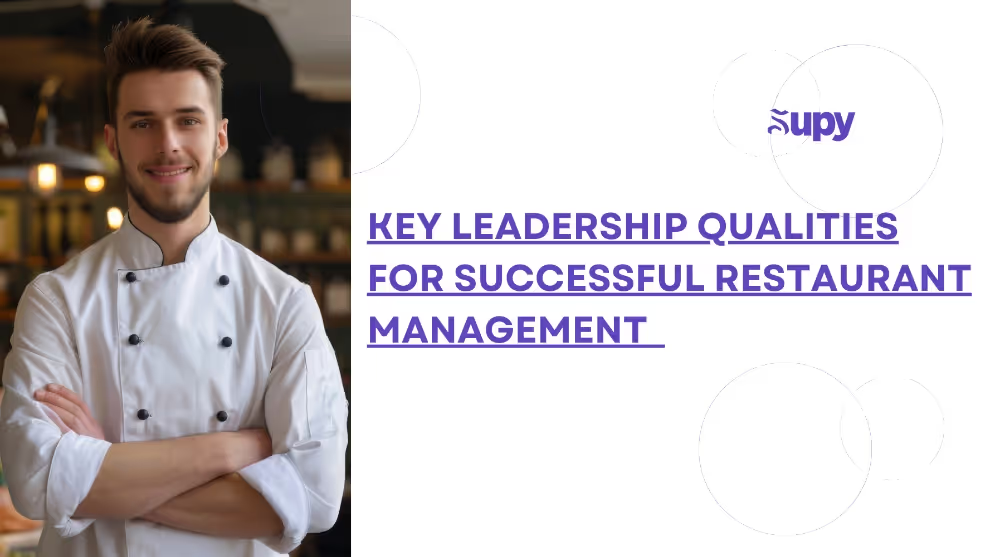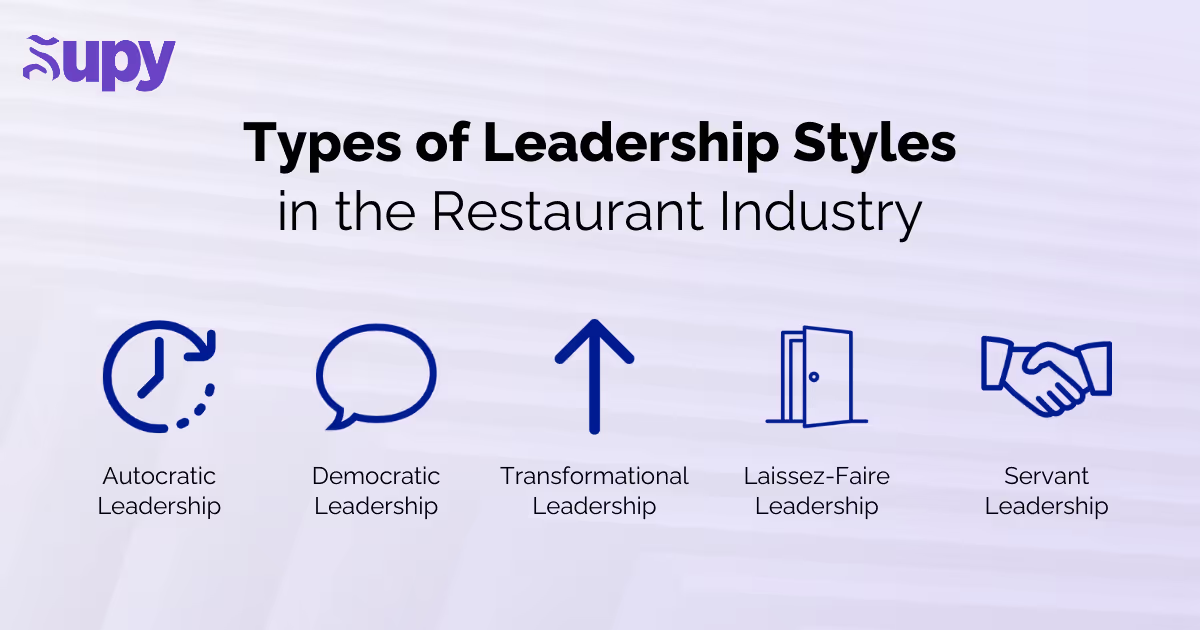Key Leadership Qualities for Successful Restaurant Management

Running a restaurant comes with many challenges, especially with an average yearly employee turnover rate of 79.6%. High turnover creates constant problems, from keeping staff motivated to ensuring the restaurant operates smoothly day-to-day. Strong leadership plays a key role in addressing these issues and keeping everything on track.
Great leaders in the restaurant industry know how to keep their teams focused and operations running seamlessly. With challenges like rising food costs and labor shortages, effective leadership becomes even more crucial. It helps reduce turnover, manage inventory efficiently, and meet the demands of a busy, fast-paced environment while also providing opportunities for career advancement within the team.
In this blog, we’ll look at:
- Types of Leadership Styles in the Restaurant Industry
- Top 7 Leadership Qualities to Drive Restaurant Management
- Conclusion
- About Supy
Focusing on strategic leadership qualities enables effective restaurant management, allowing owners to prepare their teams for long-term growth, stability, and career advancement opportunities.
1. Types of Leadership Styles in the Restaurant Industry

Different leadership styles can significantly influence how a restaurant operates and how well the team performs. Here are some common leadership styles for restaurant management:
1. Autocratic Leadership
Autocratic leaders make quick decisions without consulting the team. This style works well during busy service hours when there’s no time for discussion, such as when dealing with sudden issues like an equipment failure or a surge in customers. However, overuse of this style can demotivate employees, making it important to apply it selectively.
2. Democratic Leadership
Democratic leaders involve their team in decision-making, which can be particularly beneficial when planning menu changes or reworking service strategies. By incorporating staff input, you can foster a more engaged and collaborative team. While this style encourages team buy-in, it’s important to use it when there’s enough time to gather feedback without delaying decisions.
3. Transformational Leadership
Transformational leaders motivate and inspire their team to aim for personal and professional growth. This style is ideal for long-term projects like opening a new location or launching a brand refresh. It encourages innovation and commitment, driving employees to take ownership of their roles. However, it requires a clear vision and strong communication to be effective.
4. Laissez-Faire Leadership
Laissez-faire leaders provide their team with the freedom to make decisions independently. This style works best with highly skilled, experienced employees who can manage their tasks without much oversight, such as a seasoned head chef or experienced floor manager. However, it may lead to a lack of direction if the team requires more guidance.
5. Servant Leadership
Servant leaders prioritize their team’s needs and lead by example. This style is particularly beneficial in fostering loyalty and trust during challenging times, such as during a restaurant’s reopening or when morale is low. Actively supporting and empowering employees builds a strong, motivated team.
The most effective restaurant leaders know how to switch between these styles depending on the situation. Flexibility is key—whether the team needs clear direction during a busy shift or collaborative input when planning for the future, the right leadership style makes all the difference.
2. Top 7 Leadership Qualities to Drive Restaurant Management
Now let's take a look at what qualities do restaurant leaders actually need:
Clear Communication and Delegation
In a busy restaurant, where there are so many responsibilities, clear communication and delegation are critical to keeping operations running smoothly. Missed orders or unclear instructions can easily disrupt service, frustrate staff, and leave guests dissatisfied. A good manager ensures every team member knows their role and understands the restaurant’s goals.
Clear communication aligns both front-of-house and kitchen teams. Whether it’s sharing daily specials or managing inventory, good communication helps avoid mistakes and ensures smooth operations.
One simple way to handle this important aspect is through quick pre-shift meetings, where staff can be briefed on the day's objectives and potential challenges, making sure everyone is on the same page.
Delegation means assigning tasks with clear instructions. It’s about empowering staff to take responsibility for their duties. A good manager can delegate effectively, allowing them to focus on higher-level tasks while the team handles day-to-day aspects of the operation.
For instance, rather than saying “manage stock,” be specific: “track key ingredients and report shortages before your shift ends.” This level of clarity ensures accountability and smooth execution, helping to keep the restaurant functioning efficiently.

Expert Tips:
- Pre-Shift Meetings: Use short briefings to discuss daily goals and any potential issues.
- Communication Tools: Use apps or systems to keep staff informed and connected.
- Delegate Clearly: Assign tasks with precise instructions and clear expectations.
- Follow Up: Regularly check on task progress and offer feedback.
Building a Positive Team Culture
A restaurant’s success depends heavily on the strength of its team. According to chef Daniel Boulud, “To me, there's no great chef without a great team.”
In a fast-paced environment with so many responsibilities, stress can easily build up. Without a strong, positive culture, team members may become disengaged, leading to high turnover and inconsistency in service. A positive culture helps to create a supportive environment where employees feel valued and empowered to do their best.
A good manager knows that collaboration is key to smooth operations. Encouraging teamwork between front-of-house and kitchen staff ensures seamless communication and service, benefiting both the team and the guests. Regular feedback, celebrating small wins, and promoting a sense of belonging can greatly improve team morale and cohesion.
Trust and respect are the foundation of a positive team culture. Leaders can build trust by being transparent, listening to team members, and offering support when challenges arise. It’s essential to foster mutual respect within the team, so everyone feels they are contributing to a shared goal.
Expert Tips:
- Promote Open Communication: Create an environment where team members feel comfortable sharing ideas or concerns.
- Recognize Achievements: Celebrate both individual and team successes to boost morale and motivation.
- Encourage Team Building: Activities outside of work can help strengthen relationships and improve collaboration during service.
- Support Career Development: Provide opportunities for growth and development to retain motivated and engaged employees.
Budget and Resource Management
Effective budget and resource management is essential for any restaurant manager. With food and labor costs often making up the bulk of a restaurant’s expenses, careful control is needed to keep the business running profitably while still delivering great service.
A key part of managing a restaurant’s budget is closely monitoring food costs and reducing waste. This includes tracking inventory, portion control, and negotiating better deals with suppliers. Similarly, labor costs must be aligned with sales patterns to ensure staff schedules are optimized—preventing overstaffing during slow times or shortages when the restaurant is busy.
Resource management extends beyond food and labor. It includes smart planning around payroll, inventory, and energy usage. A good restaurant manager looks at all aspects of operations to ensure they are running smoothly and cost-effectively. This might involve reevaluating vendor contracts or optimizing kitchen processes to reduce operational costs.
Expert Tips:
- Track Food Waste: Regularly audit inventory to avoid over-ordering and reduce food costs.
- Optimize Scheduling: Use sales data to schedule staff according to demand, keeping labor costs under control.
- Review Vendor Agreements: Regularly assess vendor contracts to ensure you’re getting the best deals.
- Monitor Energy Use: Be mindful of energy consumption, which can significantly impact operating costs.
Problem Solving and Agility
In the restaurant industry, challenges can arise unexpectedly, from equipment malfunctions to sudden shifts in customer demand. Restaurant operators need to be agile, able to solve problems quickly and adapt to changing situations to keep operations running smoothly.
Whether it's a delay in supply deliveries, a staff shortage, or a process breakdown in the kitchen, quick decision-making ensures minimal disruption to both service and productivity. A strong problem-solving approach keeps the team focused and operations flowing smoothly.
Agility allows restaurant operators to adjust when unexpected situations arise. For example, if a key ingredient runs out during a busy service, an agile leader can adjust the menu on the spot, ensuring customers still have a great dining experience.
Expert Tips:
- Stay Involved: Restaurant operators should remain hands-on, monitoring daily operations and addressing issues as they arise.
- Empower the Team: Train staff to identify problems and suggest solutions, so everyone plays a role in problem-solving.
- Evaluate and Adjust: After resolving a problem, assess whether the current process needs adjustment to prevent future issues.
- Act Quickly: Responding to issues promptly minimizes the impact on customers and keeps productivity high.
Tech-Savvy Leadership and Data-Driven Decision Making

In today’s fast-paced hospitality industry, a tech-savvy mindset is a crucial leadership quality for restaurant operators. Leaders who understand the benefits of technology, particularly in areas like inventory management and business intelligence, can save time, optimize operations, and drive smarter decisions.
Incorporating technology into daily operations, such as using real-time inventory management systems, helps restaurant leaders keep accurate track of stock, preventing over-ordering or running out of key ingredients. This kind of oversight not only saves time but also cuts costs and reduces waste—boosting profit margins in the long run.
Developing a data-driven approach is essential for optimizing performance and ensuring long-term success. By using real-time data, restaurant leaders can spot inefficiencies in processes and implement solutions quickly. This level of knowledge and adaptability ensures that restaurants stay competitive and continue to grow in a challenging market.
Expert Tips:
- Invest in Inventory Management Systems: Use real-time inventory tracking to streamline orders and reduce waste.
- Use Business Intelligence Tools: Analyze key data to make informed decisions about sales, staffing, and customer preferences.
- Train Staff on Tech Tools: Ensure team members understand how to use technology effectively to reduce human error and improve efficiency.
- Stay Current: Keep up with emerging technologies in the hospitality industry to continually refine your operations.
Creating and Maintaining Customer Satisfaction
In the restaurant industry, customer satisfaction is the cornerstone of success. Beyond offering great food, creating a memorable and enjoyable experience for guests keeps them coming back. Strong leadership plays a vital role in ensuring that customer satisfaction is consistently prioritized through attentive service, responsiveness, and attention to detail.
A restaurant leader must be attuned to the evolving needs and expectations of customers. This includes everything from the quality of the food to the cleanliness of the restaurant and the professionalism of the staff. Leaders who actively interact with guests and encourage feedback through surveys, social media reviews, or direct communication can stay updated on customer preferences. This data has the power to inform operational adjustments, staff training, and even menu changes.
Delivering a consistent experience is critical to maintaining customer satisfaction. Guests expect the same high level of service every time they visit, whether it’s a regular weekday or during busy events. Establishing clear service standards and training staff to follow them ensures consistency. Leaders should monitor service regularly and step in when they notice lapses, such as delays in service or inconsistencies in how dishes are served.
Expert Tips:
- Monitor Feedback: Regularly review customer feedback to understand preferences and identify areas for improvement. This helps in balancing customer satisfaction with managing prime cost.
- Train for Consistency: Set clear service standards and train staff to meet them consistently, ensuring a positive guest experience every time.
- Encourage Proactive Service: Empower staff to anticipate guest needs, interact professionally, and solve problems before they escalate.
3. Conclusion
In the ever-evolving restaurant industry, strong leadership qualities such as clear communication, effective delegation, tech-savvy decision-making, and problem-solving are essential for long-term success. Focusing on these areas helps restaurant operators build efficient teams, optimize processes, and create a better experience for both staff and customers, ultimately driving profitability and growth in a competitive market.
To further enhance these skills, join the Restaurant & Hospitality Leadership Center by the National Restaurant Association and gain access to invaluable resources designed to strengthen your leadership and operational effectiveness.
4. About Supy
If you want your restaurant business to succeed and your leadership to be fruitful, Supy is your best partner. Designed specifically for the hospitality industry, Supy streamlines essential tasks like real-time inventory management, recipe costing, and procurement, allowing restaurant operators to focus on improving efficiency and reducing costs. With Supy, you can eliminate human error, make data-driven decisions, and ensure smooth operations across your entire business.
Take the next step towards restaurant management. Book a demo today and see how Supy can elevate your leadership and business.
Related Resources







